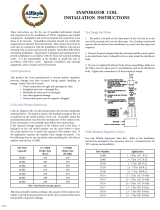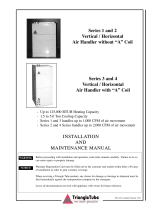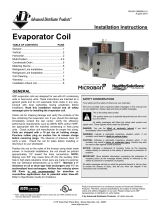
0673567-00 / 507795-01 Issue 1810 Page 1 of 8
Save these instructions for future reference
INSTALLATION INSTRUCTIONS
BCW1
Wall-Mounted Air Handler
This manual must be left with the homeowner for future reference.
This is a safety alert symbol and should never be ignored. When you see this symbol on labels or in
manuals, be alert to the potential for personal injury or death.
General
These instructions are intended as a general guide and
do not supersede local codes in any way. Consult with
authorities having jurisdiction before installation.
BCW1 air handlers are suitable for closet or ush mount
installations and are designed for electrical heat installation
with a matched remote outdoor unit. These units are
designed for indoor installations only.
The Clean Air Act of 1990 bans the intentional venting
of refrigerant (CFCs and HFCs) as of July 1, 1992.
Approved methods of reclaiming must be followed.
Fines and/or incarceration may be levied for non-
compliance.
IMPORTANT
Check equipment for shipping damage. If you nd any
damage, immediately contact the last carrier.
Check the unit rating plate for unit size, electric heat, coil,
voltage, phase etc. to be sure unit matches requirements.
Requirements
The installation of the air handler, eld wiring, air ducts, etc.
must conform to the requirements of the National Electrical
Code, ANSI/NFPA No. 70 (latest edition) in the United
States, and any state laws, and local ordinances (including
plumbing or wastewater codes). Local authorities having
jurisdiction should be consulted before installation is
made. Such applicable regulations or requirements take
precedence over the general instructions in this manual.
Install the air plenum, ducts and air lters (not provided)
in accordance with NFPA 90B Standard for the Installation
of Warm Air Heating and Air-Conditioning Systems (latest
edition).
This unit is certied for installation clearances to combustible
material as listed on the unit rating plate. Accessibility and
service clearances should be considered as well.
Comfort-Aire / Century
1900 Wellworth Ave.
Jackson, MI 49203

0673567-00 / 507795-01Issue 1810Page 2 of 8
Installation
BCW1 air handlers are suitable for free-air return when
installed in a closet with a louvered door, ush mounted
or in the wall.
Closet or “On the Wall” Applications
NOTE: If mounted in a closet, a louver or grill with at least
1 square foot of face area per cooling ton is required on
the door.
A wall hanging bracket is available as an accessory for this
type of mounting. Attach bracket to wall so the “open” end
faces up, make sure bracket is level and attached to the
studs (2” x 8” blocking installed between studs at bracket
height is recommended). 2″ screws are required. Lift unit
and slide the back edge of the top cap onto bracket.
Figure 1.
Flush Mount or “In the Wall” Applications
Recess air handler 2″ to provide adequate space for drain
line connections. If a ush application is desired, a notch
will need to be cut in the stud to allow for primary drain
access. Do not allow the air handler to protrude beyond
the front of the stud; this will interfere with the louvered wall
grille application. Use the 2 holes on each side to attach
between studs. Make sure air handler is level and square
before proceeding.
Ductwork
Ductwork should be fabricated and installed in accordance
with local and/or national codes. This includes the
standards of the National Fire Protection Association for
installation of Air-Conditioning and Ventilating Systems,
NFPA No. 90B.
Figure 2.
Condensate Drain
Determine the drain connections to be used and note
the difference between the primary and secondary
openings. Remove plugs from selected drain openings. It
is recommended that ¾″ male pipe thread PVC ttings be
used at the condensate pan. Hand tighten.
Tubing for all condensate drains should be a minimum of
7/8″ OD. The drain should be pitched downward 1″ per 10′.
Install a 3″ trap as close to the coil as possible.
A
C
B
A: Anti-siphon air vent
B: Drain trap
C: Drain line
Figure 3.
Route drain line so that it does not interfere with accessibility
to the coil, air handling system or lter and will not be
exposed to freezing temperatures.
If line makes a second trap, or has an extended run before
termination, a vent tee should be installed after the trap
closest to the pan. Connect the primary drain and route to
an open drain, sump, or sewer line.

0673567-00 / 507795-01 Issue 1810 Page 3 of 8
If the coil is located in or above a living space where
damage may result from condensate overow, a
separate ¾″ drain must be provided from the secondary
drain connection (or a Float Switch can be used - refer
to kit instructions for installation procedures). Run this
drain to a place in compliance with local installation
codes where it will be noticed when unit is operational.
Condensate owing from the secondary drain indicates
a plugged primary drain.
Prime the trap with water. Test line for leaks. Verify
water ow with unit in operation.
CAUTION
Wiring
Electric shock hazard. Can cause injury or death. Before
attempting to perform any service or maintenance,
turn the electrical power to the unit OFF at disconnect
switch(es). Unit may have multiple power supplies.
DANGER
Use Copper Conductors Only
WARNING
Run 24V Class 11 wiring only through the specied
low voltage opening. Run the line voltage wiring only
through the specied high voltage opening. Do not
combine Voltage in one opening.
WARNING
Wiring must conform to the current National Electric Code
ANSI/NFPA No. 70, or Canadian Electric Code Part 1, CSA
Standard C22.1, and local electric codes. See the unit
nameplate for minimum circuit ampacity and maximum
overcurrent protection size.
Select the proper supply circuit conductors according to
tables 310-16 and 310-17 in the National Electric Code,
ANSI/NFPA NO. 70 or Tables 1-–4 in the Canadian Electric
Code, Part 1, CSA Standard C22.1.
Refrigerant Piping
Coil refrigerant connections are 3/8″ ODF Liquid and
3/4″ ODF Suction. Refer to outdoor unit manufacturer’s
recommendation on line sizing.
During brazing of refrigerant lines place a wet rag around
suction line on top of cabinet to protect cabinet from
overheating. Maintain a minimum of 1.5″ from cabinet and
refrigerant brazing connections.
Refrigerant Flow Controls
Refer to nomenclature to determine type of ow control
installed and needed for your application. Evaporator coils
are shipped from the factory with orator pistons or TXV
assemblies. Florator pistons and TXV kits are available for
eld conversion.
Pistons
As shipped from the factory, the piston installed in each coil
is chosen for the nominal BTUH capacity of the coil. Verify
with the condenser recommendation that proper orator
piston is selected. Replace the piston per the outdoor unit
instructions.
When changing pistons use the following procedure:
1. Loosen hex nut located on liquid line and separate
from distributor assembly.
2. Remove the existing piston from inside the distributor
assembly
3. Insert the desired piston into the distributor assembly.
4. Replace “O” ring with a new one.
5. Re-install hex nut to body and torque to 10 ft-lbs.
Thermal Expansion Valves
As shipped from the factory, the TXV installed in each coil
is chosen for the nominal BTUH capacity of the coil. Attach
and insulate the TXV bulb outside of the cabinet to the
main suction line no more than one foot from the suction
line connection. The bulb must be insulated.
Field installed TXV kits are also available. Refer to
engineering guide or price sheet for sizes, and kit
instructions for installation procedures.
Refrigerant Line Installation
Allied Air recommends installing a lter drier in the liquid
line, per outdoor unit instructions. While brazing, purge
the system with Nitrogen to prevent contamination. Attach
TXV bulb only after brazing line sets at a 10 to 2 o’clock
position on the suction line, outside the coil housing, no
more than one foot from the connection. Evacuate the
system to 500 microns to ensure proper air and moisture
removal (Note: Deep evacuation or triple evacuation
method recommended). Open the suction service valve
slowly and allow the refrigerant to bleed into the system
before opening the liquid service valve.
Refrigerant Charging
Refer to the outdoor unit instructions for proper system
charging.

0673567-00 / 507795-01Issue 1810Page 4 of 8
Blower Speed Changes
To change motor speed, settings remove motor wire from
control board and replace with desired speed. See Table 3
or Table 4 for airow performance.
Maintenance & Repair
At the beginning of each heating or cooling season
the unit should be serviced by a qualied installer or
servicing agency.
CAUTION
If necessary to access the air handler blower motor for
replacement, follow these steps:
1. Ensure all power is shut off to the unit
2. Remove the (4) ¼” screws located on each side of the
coil (two per side).
3. Remove the (2) ¼” screws in the top plate on the coil,
and set the top cap to the side.
4. Gently pick the coil up out of the drain pan and slowly
rotate the coil toward you. Ensure that the copper ex
tube is bending in the middle and not kinking (see
Figure 4).
5. Stabilize the raised coil while servicing the motor.
6. Reverse the steps above to put the coil back into place.
Figure 4.
Electrical Data
Unit Size
(all have electric heat)
Heating Capacity
Blower Amps
Minimum Circuit
Ampacity
Circuit Breaker
Amps per Stage
kW BTUH
*240 V *240 V 208 V 240 V 208 V 240 V
18
5.0 17,065 1.8 1.7 24.8 28.2 30
7.5 25,598 1.8 1.7 36.1 41.2 45
10.0 34,130 1.8 1.7 47.4 54.2 60
24
5.0 17,065 1.8 1.7 24.8 28.2 30
7.5 25,598 1.8 1.7 36.1 41.2 45
10.0 34,130 1.8 1.7 47.4 54.2 60
30
5.0 17,065 2.1 2.0 25.2 28.5 30
7.5 25,598 2.1 2.0 36.5 41.6 45
10.0 34,130 2.1 2.0 47.8 54.6 60
36
5.0 17,065 2.1 2.0 25.2 28.5 30
7.5 25,598 2.1 2.0 36.5 41.6 45
10.0 34,130 2.1 2.0 47.8 54.6 60
* For 208 V, use .751 correction factor for kW & MBTUH.
Table 1. 3-Speed PSC Motor

0673567-00 / 507795-01 Issue 1810 Page 5 of 8
Airow Data
NOTE: Heating speeds should not be reduced below
factory setting.
NOTE: Different speeds can be set for cooling mode; see
installation instructions.
Unit
Size
Cooling Speed
Setting
Airow (CFM) vs. External Static
Pressure (in. w.c.) ***
0.1 0.2 0.3 0.4 0.5
18
* ^ Low - Red 606 591 576 559 529
Med - Blue 802 784 751 722 693
High -Black 1046 1013 987 943 885
24
Low - Red 606 591 576 559 529
* ^ Med - Blue 802 784 751 722 693
High -Black 1046 1013 987 943 885
30
Low - Red 816 809 802 775 752
* ^ Med - Blue 1000 985 970 935 889
High -Black 1218 1175 1122 1070 1008
36
Low - Red 816 809 802 775 752
Med - Blue 1000 985 970 935 889
* ^ High -Black 1218 1175 1122 1070 1008
* Factory setting for cooling.
^ Factory setting for heating.
*** All airow data is with a dry coil, lter, & electric heat.
Table 3. 3-Speed PSC Motor
Unit
Size
Cooling
Speed
Setting
Airow (CFM) vs. External Static
Pressure (in. w.c.) ***
0.1 0.2 0.3 0.4 0.5
19
Tap 1 547 484 366 309 268
* Tap 2 651 600 566 516 466
Tap 3 695 646 617 566 544
^ Tap 4 742 700 669 627 600
Tap 5 758 712 682 641 625
25
Tap 1 569 453 347 264 264
Tap 2 659 600 569 518 475
* Tap 3 847 800 787 744 722
^ Tap 4 928 901 883 846 802
Tap 5 970 944 927 891 864
31
Tap 1 656 600 567 522 473
Tap 2 842 800 782 739 716
* Tap 3 1059 1028 1004 972 946
^ Tap 4 1106 1084 1053 1030 1000
Tap 5 1137 1108 1085 1055 1031
37
Tap 1 848 800 769 726 692
Tap 2 1051 1028 1000 956 930
* Tap 3 1247 1215 1188 1161 1126
^ Tap 4 1310 1279 1254 1228 1200
Tap 5 1364 1334 1304 1279 1250
* Factory setting for cooling.
^ Factory setting for heating.
*** All airow data is with a dry coil, lter, & electric heat.
Table 4. 5-Speed High Efciency ECM Motor
Unit Size
(all have electric heat)
Heating Capacity
Blower Amps
Minimum Circuit
Ampacity
Circuit Breaker
Amps per Stage
kW BTUH
*240 V *240 V 208 V 240 V 208 V 240 V
19
5.0 17,065 0.9 0.8 23.7 27.0 30
7.5 25,598 0.9 0.8 35.0 40.1 45
10.0 34,130 0.9 0.8 46.3 53.1 60
25
5.0 17,065 1.8 1.7 24.8 28.2 30
7.5 25,598 1.8 1.7 36.1 41.2 45
10.0 34,130 1.8 1.7 47.4 54.2 60
31
5.0 17,065 2.4 2.2 25.6 28.8 30
7.5 25,598 2.4 2.2 36.8 41.8 45
10.0 34,130 2.4 2.2 48.1 54.8 60
37
5.0 17,065 3.1 2.9 26.4 29.7 30
7.5 25,598 3.1 2.9 37.7 42.7 45
10.0 34,130 3.1 2.9 49.0 55.7 60
* For 208 V, use .751 correction factor for kW & MBTUH.
Table 2. 5-Speed High Efciency ECM Motor

0673567-00 / 507795-01Issue 1810Page 6 of 8
Low Voltage Thermostat Connections
3-Speed Motor
5-Speed High Efciency ECM Motor
For high static system, identify desired tap/CFM and jumper “Y1” & “DS” at air handler terminal block.
For 2 stage outdoor units:
• Identify desired tap/CFM for 1st stage from airow chart and move motor lead on terminal board to Y1.
• Identify desired tap/CFM for 2nd stage from airow chart and move motor lead on terminal board to Y2.
Cooling Application with Electric Heat
Heat Pump Application with Electric Heat

0673567-00 / 507795-01 Issue 1810 Page 7 of 8
Figure 5. 3-Speed Motor Wiring Diagram

0673567-00 / 507795-01Issue 1810Page 8 of 8
Figure 6. 5-Speed High Efciency ECM Motor Wiring Diagram
-
 1
1
-
 2
2
-
 3
3
-
 4
4
-
 5
5
-
 6
6
-
 7
7
-
 8
8
Century 1.901203 Installation, Operation & Maintenance Manual
- Type
- Installation, Operation & Maintenance Manual
Ask a question and I''ll find the answer in the document
Finding information in a document is now easier with AI
Related papers
Other documents
-
Broan Louvered Panel Accessory for Vertical Wall Mount AH Installation guide
-
Broan B64BMM(O,X) Installation guide
-
 Allstyle Coil AS36A344E5 Installation guide
Allstyle Coil AS36A344E5 Installation guide
-
 TriangleTube 2 Series Installation guide
TriangleTube 2 Series Installation guide
-
PSG PF01015 Assembly Instructions
-
 Advanced Distributor Products RG35948C210B22R Installation guide
Advanced Distributor Products RG35948C210B22R Installation guide
-
Bard I36Z1-C Installation Instructions Manual
-
Bard I36Z1-C Installation Instructions Manual
-
Advanced Distributor Products RE35648D245B2205AP Installation guide
-
Bard I36H1 User manual










